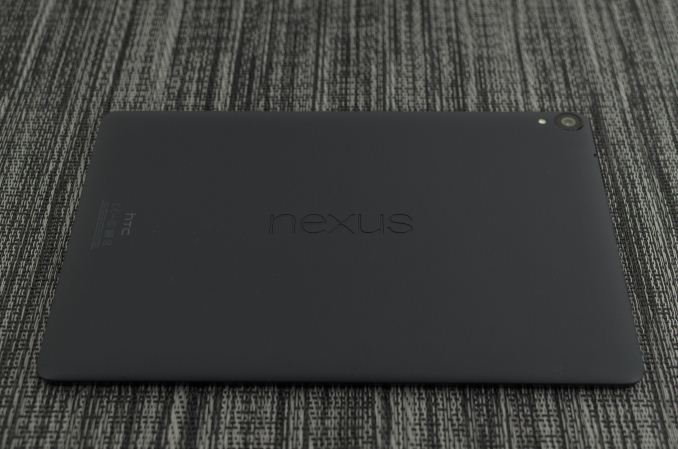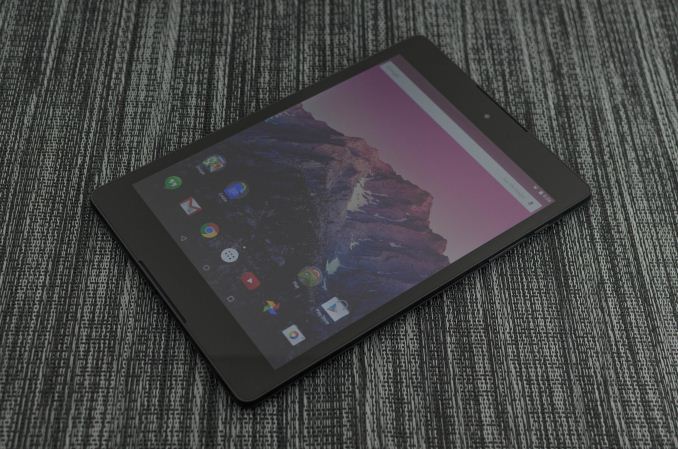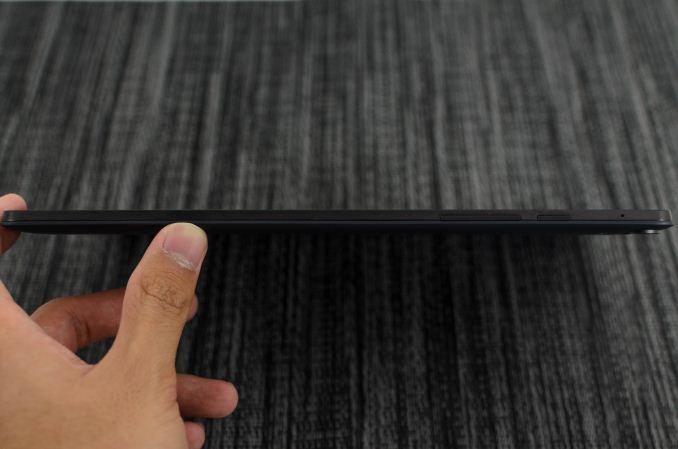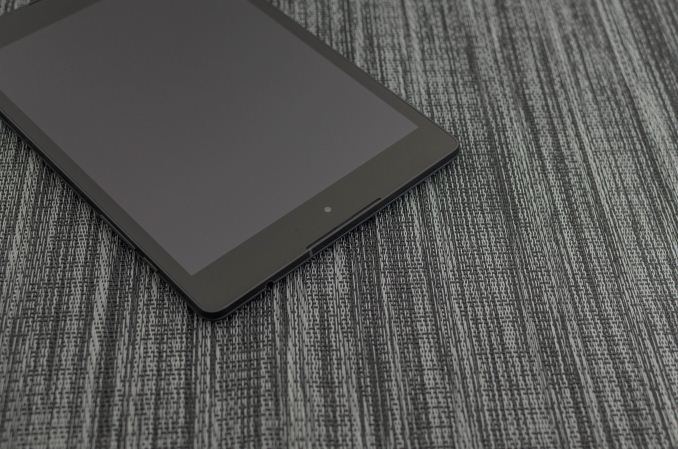Google Nexus 9: Preliminary Findings
by Joshua Ho on November 3, 2014 1:00 PM EST
For a few years now, Google has had a generally consistent tablet strategy. Instead of chasing after the ~10 inch tablet segment and focusing upon the high end, we’ve seen tablets closer to the ~7 inch display size at extremely low cost. While this has been an immensely successful strategy in driving hardware adoption, the formfactor made it possible for the tablet to be closer to a large phone than a small tablet. The flexibility of Android’s scaling system meant that an app designed for a phone worked acceptably well for a small tablet, even if the space efficiency was a bit poor. There’s no question that the Nexus 7 (2013) was and still is a great tablet, but even now it’s obvious that there’s a dearth of applications designed specifically for the larger display. The other issue is that of cost. With the Nexus 7 line, Google managed to integrate an incredible amount of hardware into a tablet priced well below the ~500 USD price point that the original iPad established. This is great for the consumer and no doubt great for Google, but the Nexus 7 line was good enough that there wasn’t much in the way of competition.
This brings us to the Nexus 9, Google’s attempt at changing the Android tablet space. From the start, this device seems to be intent on pushing the Android tablet to a more premium segment. Rather than a purely cost-optimized polymer design, we see the addition of an aluminum ring that runs around the side of the device, which definitely helps with in-hand feel. The tablet itself seems to have high-end aspirations as the launch platform for NVIDIA’s Tegra K1-64, which has two Denver CPU cores rather than the traditional 4+1 Cortex A15 setup, along with dual front-facing speakers and a large 9” display with 4:3 aspect ratio. I’ve included the basic specs in a spec sheet below, to avoid spending too much time going over the basics.
| Nexus 9 | |
| SoC | 2.3GHz 64-bit dual core Tegra K1 Denver SoC |
| RAM/NAND | 2GB LPDDR3 + 16/32GB NAND |
| Display | 8.9" 2048x1536 IPS LCD |
| Network | WiFi only or 2G / 3G / 4G LTE SKU |
| Dimensions | 153.68 x 228.25 x 7.95mm, 425g WiFi, 436g LTE |
| Camera | 8MP Rear Facing (IMX219) with F/2.4 aperture, 1.6MP FFC (OV9760) |
| Battery | 6700 mAh (25.46 Whr) |
| OS | Android 5.0 Lollipop |
| Connectivity | 802.11a/b/g/n/ac + BT 4.1, USB2.0, GPS/GNSS, NFC |
Unfortunately, in the case of the Nexus 9 while we can make some early observations the version of firmware that we received dates was built on August 29th, and in the time since it’s quite likely that there have been significant changes in all directions. We still don't have a newer build, so all the tests will be done on older firmware. The full review will have final numbers as it will be done using shipping firmware.
At any rate, the hardware of the Nexus 9 definitely fits the bill of a premium tablet. While for the most part every Nexus device in the past year has shared the same industrial and material design elements, HTC seems to have added a few extra touches to differentiate this product from other Nexus devices. The most obvious and prominent of these touches is the metal ring, which has a brushed texture similar to what we saw on the M8.
There are also dual front-facing speakers that flank the display, which are definitely great for video and music content when compared to a single speaker on the bottom or back of the device. However, for the most part the design is very much a Nexus device with its minimalistic design and soft-touch plastic back cover.













146 Comments
View All Comments
tuxRoller - Tuesday, November 4, 2014 - link
Pardon, that should've been relatively (as a linear function of screen area it comes to 176 mAh/in2 vs 163 for the ipad).As for the N4, well, I'd simply forgotten about it. However, we still don't have benchmarks for it in 64bit mode. As it is, it seems to be a bit slower than the a15 which shouldn't be the case.
chizow - Tuesday, November 4, 2014 - link
But the N9 has the brighter screen and a smaller battery, and yet N9 has slightly battery life. Not sure how you can be disappointed in this Nvidia effort when they have matched Apple's performance without needing to leverage 20nm and they have in most cases, doubled performance relative to the next closest Android ARM-based competitor and left Intel's Atom based offerings in the rear view as well. Cherry Trail might have proved an interesting part here, but its been delayed, so right now its clear there are really only two choices in the tablet SoC market for pure performance: A8X and Denver K1.testbug00 - Tuesday, November 4, 2014 - link
because the CPU and GPU use all the power in battery life tests, right? The brightness is not equalized, wifi doesn't draw power. Just the SoC.Oh, wait, the screens are standardized to 200nits brightness. And the bightlight is added to power, the wifi is adding to power, the digitizer is adding to power... Wifi tests using are not demanding, so, the SoC is more likely in a low power state, which, makes everything else besides the backlight take a lot more in terms of percentage than normally they would (backlight is still the largest power usage after SoC iirc, with a notable gap between those two and everything else)
Could it be possible that when you equalize the screen brightness (should be able equal power draw) that perhaps a larger screen matters more? Everything else should be about equal.
Low power usage for low power states of the SoCs, wifi radios about the same power, except, the iPad screen is ~29000mm^2, The Nexus 9 is about ~25500mm^2 on its screen.
Do you think that having about a 13% larger area to backlight would reasonably give under 1% less battery life given the battery is only 7% larger?
Apple's chip is likely more effective. The margin by which it is more effective is hard to tell without knowing what percentage of the power draw the tablets each had from the SoC. I would guess at least 15-20%. Which, would mean WORST CASE for Apple, Nvidia's chip's power consumption would be equal at the same node (more or less).
On that note, I think that a K1 A15r3 would likely be faster absolutely as a SoC. Granted, most things don't use 4 threads =]
tuxRoller - Tuesday, November 4, 2014 - link
The brighter screen doesn't matter as the test is done at the same brightness, and the runtimes differed by less than a minute.20nm doesn't make the performance any better unless you actually clock your cpus higher. Apple, iirc, only moved their clocks up 100MHz, to 1.4, while denver is running at 2.3.
I'm dissapointed b/c it looks like denver CAN be fast, but only if running one or two apps for long periods (filling the cache with that vliw optimized code). When multitasking it apparently has serious issues. Hopefully these can be addressed in future revisions to denver.
I'm not comparing denver to atom or other current android offerings as none of them have attempted to go use a radically different arch from everyone else.
DERSS - Wednesday, November 5, 2014 - link
"But the N9 has the brighter screen and a smaller battery, and yet N9 has slightly battery life" -- battery life is measured with equal brightness, so K1's longer battery life is result of smaller screen and dramatical throttling slowdown which is unavoidable since it is 28 nm process (versus 20 nm in A8X).kron123456789 - Wednesday, November 5, 2014 - link
What "dramatical throttling slowdown" are you talking about? Do you know what "throttling" means?DERSS - Thursday, November 6, 2014 - link
Yes, clock drops down to SoC not to overheat and to save battery life.testbug00 - Thursday, November 6, 2014 - link
in a web browsing test? The CPU isn't high enough to throttle... Or, if it is the webpage is more intensive than an 'average' mobile web page, OR, the SoC is terribly designed.While I am very down on Nvidia's mobile efforts due to peak power draws and throttling, it shouldn't be throttling anymore than the A8X in sane web browsing tests...
melgross - Monday, November 3, 2014 - link
We were being told that ARM could never compete with x86, but the A8x is stronger than most i3 low power chips. I assume this new Tegra is somewhere around that as well. The fact that it does compare with a three year old i5 notebook is something that I find incredible.Considering that Apple and possibly others, will continue to upgrade performance in their ARM offerings by substantially greater amounts than Intel is able to with x86, for at least the next few years, means that Intel really does have something to worry about.
kron123456789 - Monday, November 3, 2014 - link
Yeah, but here's what i think — iPad Air 2 and Nexus 9(and all Tegra K1 devices as well) has so much power and that power is used ONLY in benchmarks.